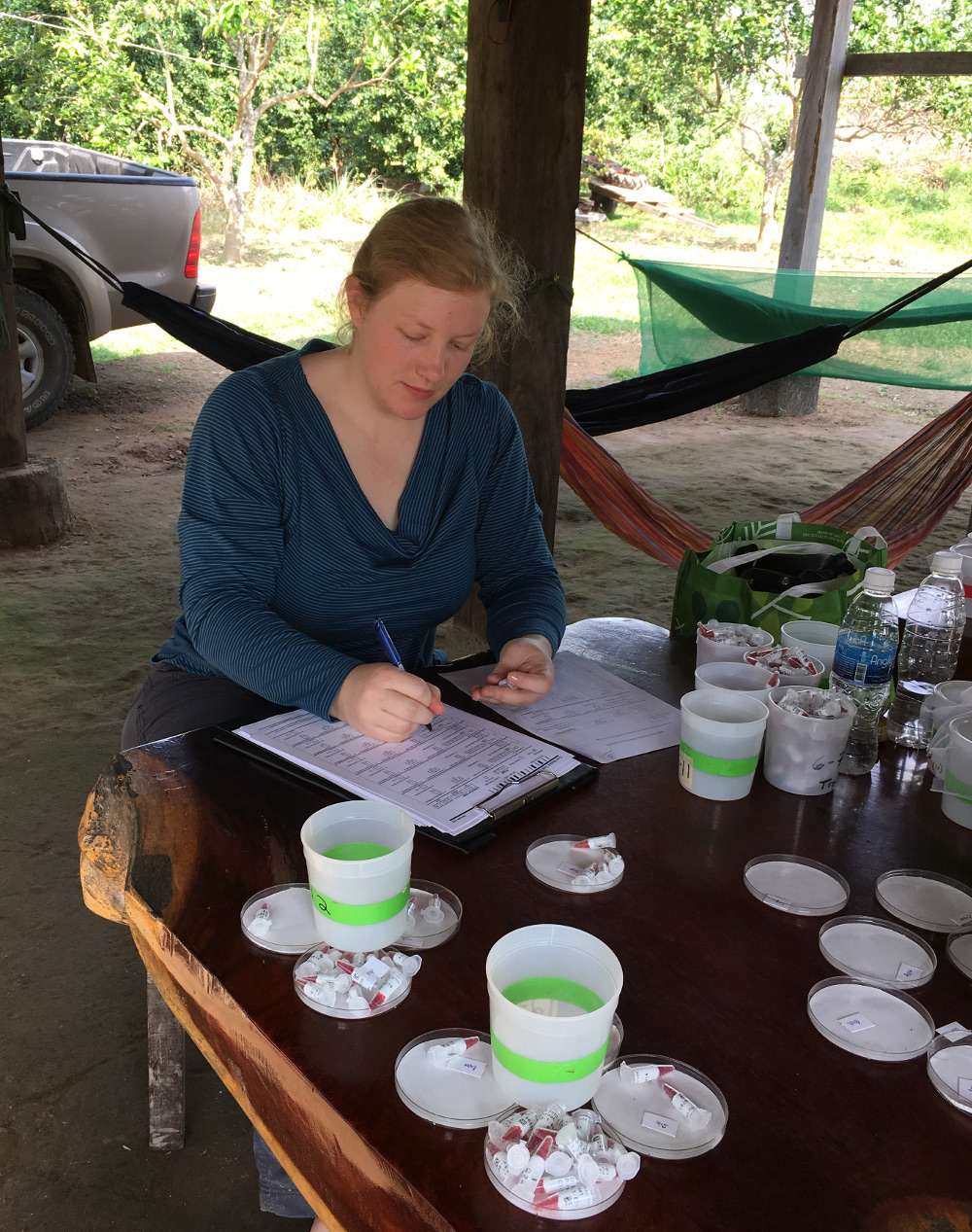
Could you introduce yourself and a little about your research?
I am a malaria mosquito ecologist. I am interested in the biology, behavior, and ecology of mosquitoes that transmit malaria parasites. A lot of my work has been focused on field studies of malaria vectors in Southeast Asia, a region of very diverse parasites and mosquitoes. The main drive of my work is investigating how Anopheles species diversity impacts malaria transmission, all with an eye toward developing better strategies to control and eliminate malaria.
After many years of doing field studies in different parts of the tropics, I am currently leading several population genomic studies centered around several malaria vector species from my field collections in Cambodia, including Anopheles minimus, An. maculatus, and An. barbirostris,as well as a collaborative project looking at An. dirus mosquitoesfrom three different countries in Southeast Asia. These studies are part of the MalariaGEN Vector Observatory.
How has your research in mosquito ecology and genomics developed?
Most of my Ph.D and postdoctoral work was focused on the population genetics and behaviors of malaria vectors in different transmission environments. During my postdoc at the NIH, I started to focus on malaria transmission in Cambodia, an area where different populations of drug-resistant malaria parasites are continuing to emerge and spread. I did infectious feed experiments with these parasites in the lab as well as field studies to dig into how these mosquitoes and parasites were interacting in the real world. We found an amazing amount of species diversity at different sites as well as multiple species being able to carry these drug-resistant parasites. The malaria group at the Wellcome Sanger Institute had been involved in characterizing the parasite populations that we were interested in using genomics, and that’s where our collaboration started. I came over to the UK as a visiting scientist to learn to do whole genome sequence analyses of some of my Cambodian mosquitoes, and am now a staff scientist in the malaria group. This collaboration has expanded into multiple projects and it is really exciting to be able to follow my mosquitoes all the way from designing and carrying out field collections to this level of genome investigation.
I have really benefitted from the experience of folks involved in the Anopheles gambiae 1000 Genomes consortium (Ag1000G). This is a dataset of now more than 3,000 individual mosquitoes belonging to the Anopheles gambiae complex, collected in sites across Africa. This group of researchers, including some within our MalariaGEN group, have developed a really great set of pipelines and tools for looking at population genomic data in Anopheles, which I am now applying to Southeast Asian vector species from my collections.
Why are malaria vectors so well adapted to transmitting this parasite?
Only mosquitoes in the genus Anopheles can transmit human malaria. Anopheles mosquitoes are highly specialized bloodfeeding flies and malaria parasites have evolved to take advantage of that bloodfeeding behavior as part of their lifecycle to get from one human host to another. The ability of any one species to carry and transmit a pathogen depends on many different factors, including the genetics of the mosquito and the parasite, mosquito behavior, and the environment in which transmission is happening. Once a mosquito picks up a parasite in a human bloodmeal, the parasite has to infect multiple cell types within the mosquito to fully develop and be transmitted via a mosquito bite to another human. There are underlying genetic and physiological factors involved in how well that mosquito might defend itself against infection at any of these stages, and very few parasites are successful. The innate susceptibility of a mosquito to a pathogen is something we call vector competence. Highly competent mosquitoes are more likely to transmit malaria parasites. Interestingly, though Anopheles mosquitoes can transmit malaria parasites, they are not competent vectors of most mosquito-borne viruses such as Dengue or Zika. Similarly, mosquitoes that do transmit viruses well (like Aedes species) are not able transmit malaria parasites.
Anopheles mosquitoes feed on multiple hosts to acquire bloodmeals to develop their eggs, including humans. Those that are more attracted to humans (like An. coluzzii and An. gambiae in Africa, and An. dirus in Southeast Asia) are more likely to pick up human parasites. The timing of parasite development in these mosquitoes is dependent on environmental conditions like temperature. The combination of mosquito behaviors, the number of mosquitoes that are around, along with vector competence, is something we call vectorial capacity. Anopheles species vary in their vector competence and in their behaviors, and the resulting vectorial capacity helps to describe disease transmission risk. Places with high malaria transmission have very competent and abundant vectors, vectors that frequently feed on humans, and a lot of parasites in circulation in the human population.
Can you talk about transitioning from mosquito fieldwork in Southeast Asia and Africa to genomic analysis of Anopheles populations?
This is not a permanent transition, I am a field mosquito biologist at heart, and have plans for many more field projects. I had this great opportunity to delve deeper into the biology of my field collected mosquitoes using genomics and am lucky to have had these last few years to learn how to code and do population genomic analyses. One of the burning questions that I had was – in the context of highly structured parasite populations in Cambodia, what is the population structure of the vectors? I was able to use genomics to start to answer that question. There is a lot of work to do for many different species, so I think this is a very rich field of research. I am currently applying for faculty positions and hope to combine this genomic work with field and lab studies in my own research group.
How is genomics helping in our understanding of anopheles population structure and the ecology of malaria transmission?
Genomics allows us to dig a bit deeper into the evolutionary history of field-collected mosquitoes. The datasets we are analysing are just as important as the analysis, while genomics can tell us about evolutionary signals and genetic variation, we can only learn about the ecology of these vectors from well-designed field studies. Longitudinal datasets in particular are needed to look at population structure and changes in populations over time and geographical space.
The Ag1000G consortium is the best current demonstration of how we might use these data. The highly collaborative Ag1000G work has shown a very high level of genetic diversity in vector populations and the rapid evolution and spread of insecticide resistance. There was a surprising amount of gene flow between even very distant populations of An. gambiae in Africa with strong signals of selection associated with DDT and pyrethroid insecticides, due to large-scale implementation of malaria vector control. These types of data show us how vectors have responded to evolutionary pressures in the past and help us to develop new strategies for vector control.
Given the diversity of SE Asian anopheles mosquitoes, there must be a lot of genetic variation – what sort of variation do you see so far?
There are several types of genetic variation to consider:
Species-level diversity – Which species are around? How many species occur in one place? How do species change over time?
Population-level variation – Do individuals belong to one large population or distinct populations? If there are distinct populations, how different are they? What are the genomic signatures of different populations?
Variation within populations – What sort of genetic variation exists in individual mosquitoes within a population? This sort of variation might be at a single SNP, such as a mutation that confers increased resistance to an insecticide.
As an example, the first of the Southeast Asian vector population genomic studies I mentioned involved taking a look at An. minimus mosquitoes collected in different sites over multiple years in Cambodia. This is the first look into population genomics of a malaria vector species outside of Africa at this scale (stay tuned for this paper and dataset). So far, we have found population structure within An. minimus s.s. in Cambodia, with multiple diverging populations, and that there are strong signals of evolutionary selection within these populations. Some of these signals look like they could be associated with the evolution of different types of insecticide resistance.
This is all new information about An. minimus, and the structuring of these populations has important implications for how one might approach controlling this species to reduce malaria cases. Because these An. minimus were collected in the context of very high species diversity, we will do the same sort of analyses with other species collected from the same sites and it will be very interesting to see if they are structured in the same way and if they have the similar selection signals that we have identified in An. minimus. So, in Southeast Asia there are a lot of species around, and there may be a very high level of variation within each species as well.
Why do you think there is such species diversity of Anopheles in SE Asia and not in Africa?
There is actually a lot of diversity of Anopheles species in many parts of Africa as well. Southeast Asia has a particularly diverse set of anophelines compared to some other parts of the tropics because although there is a dry season, it is not as intense as the dry season in many African countries, this enables Anopheles species to be more abundant throughout the year, with plenty of places to rest and breed, even during the dry season.
The behaviors of malaria vector mosquitoes in a lot of Southeast Asia is also different, with most mosquitoes biting and resting outdoors, these outdoor behaviors make these mosquitoes more difficult to control.
What does Anopheles genomics still need to tackle to play a part in malaria control?
Accurate and inexpensive tools for species identification, good quality and diverse reference genomes, and longitudinal datasets of different vectors will be key to using these types of data to inform malaria control and elimination efforts. A few of the challenges of having many different Anopheles species around are that they can be hard to identify and there are not many reference genomes available to leverage for the analysis of wild-caught mosquitoes. There are dozens of important malaria vectors across the tropics that we have extremely sparse data about, and in areas with diverse vector species this picture starts to get very complicated. There is a need for more references in general as well as a better representation of genetic and genomic data from across the Anopheles taxon. Each dataset, whether it is the addition of a new collection site or another species, helps to expand what we know about Anopheles mosquito biology.
One of the most useful bits of information for malaria control programs regarding mosquitoes is their insecticide resistance status. Genetic and genomic surveillance of mosquitoes can help to identify different types of insecticide resistance markers and changes within populations of vectors over time and in response to the implementation of vector control interventions. It can also help to describe a landscape in which one insecticide might be more effective compared to another one. One of the challenges of this level of analysis is getting information back to national malaria control programs within a timeframe that is useful, so any sequencing and analysis needs to be fast with the resulting data shared quickly. Ideally, malaria control programs would be directly involved in the sequencing, analysis, and interpretation of these data. I think the accessibility and cost of sequencing technology is a major current barrier for Anopheles genomics having a direct informative impact for malaria control.


